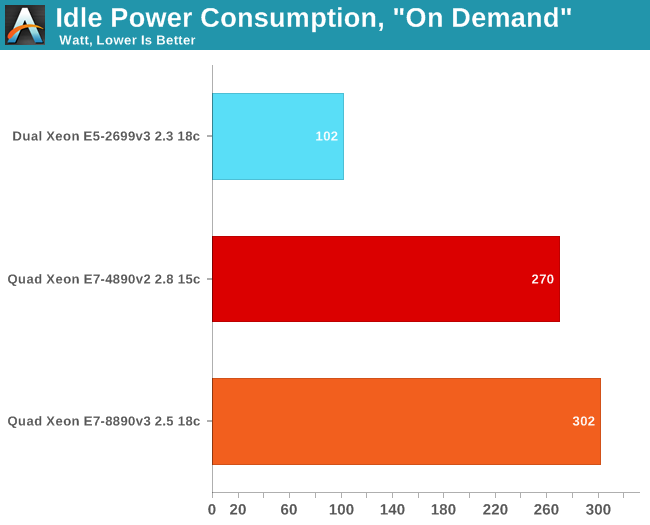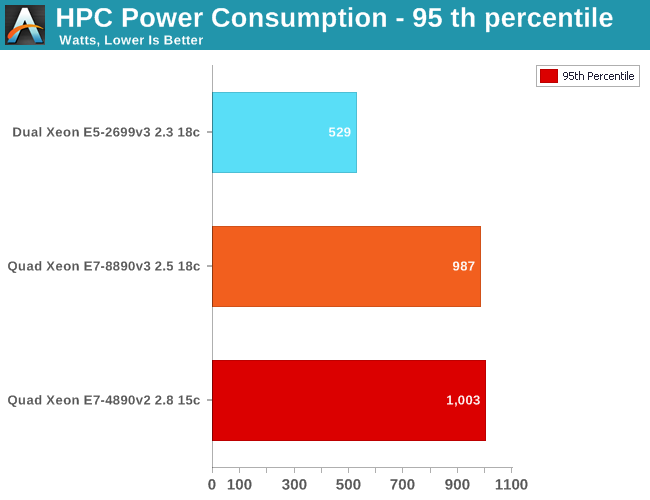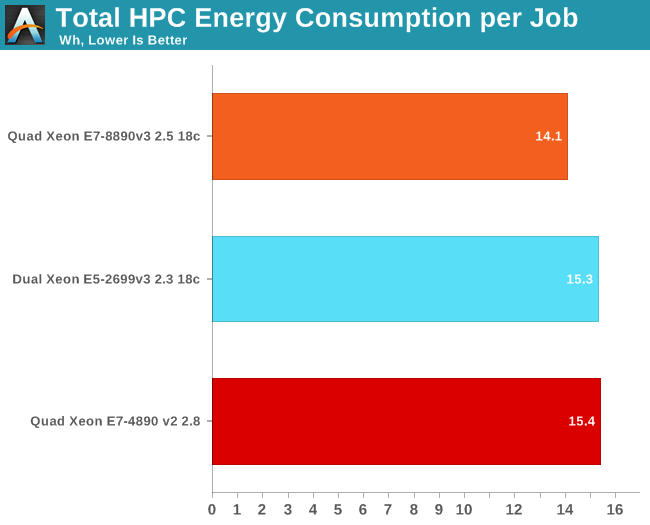The Intel Xeon E7-8800 v3 Review: The POWER8 Killer?
by Johan De Gelas on May 8, 2015 8:00 AM EST- Posted in
- CPUs
- IT Computing
- Intel
- Xeon
- Haswell
- Enterprise
- server
- Enterprise CPUs
- POWER
- POWER8
HPC: Watts per Job
Last, but not least, we have a look at power consumption. First we measure idle power consumption.

We did not expect the E7 v3 to consume more energy at idle than the previous E7, but sure enough it did. Maybe the DDR4 memory buffers (Jordan Creek 2) need more energy than the previous ones?
For load power testing we used the OpenFOAM test and measured at the 95th percentile, which is basically the power consumed when processing the most parallel part.

These quad socket systems are made for reliability, and not quite as much as for performance-per-watt. The end result is that these quad socket servers need about as much power as your fabric iron. To put this in perspective: the Xeon E5-2699v3 is considered a real power hog among the Xeon E5s. Most of the other dual Xeon E5 servers are in the 390-450W range.
Let us see how much watt we need for each OpenFOAM job.

The new Xeon E7-8890v3 is a tiny bit more efficient, but it is almost neglible.










146 Comments
View All Comments
MyNuts - Tuesday, May 12, 2015 - link
Charles Babbage would be upsetquadibloc - Thursday, May 14, 2015 - link
I'm shocked to hear that Oracle and IBM are charging more for their SPARC and PowerPC chips, respectively, than Intel is charging for comparable x86 chips - or, at least, I presume they are, if servers using those chips are more expensive. Since x86 has the enormous advantage of being able to run Microsoft Windows, the only way other ISAs can be viable is if they offer better performance or a lower price.Kevin G - Thursday, May 14, 2015 - link
Actually IBM comes in cheaper than Intel for comparable POWER8 hardware. IBM now is offering the processor to outside system builders so the actual prices are some what known. Tyan used to have the raw prices on their site but I can't find them again.Regardless, this article indicates that they top out at $3000 which is less than equivalent Xeon E7's.
kgardas - Thursday, May 21, 2015 - link
Sure, SPARC and POWER are (was in case of POWER) more expensive, but usually hardware price is nothing in comparison with software price if you are running enterprise. Also SPARC is also Oracle preferred over POWER/Itanium by Oracle's price ratios... Anyway, POWER8 looks so powerful that it may even be cheaper software wise in comparison with SPARC, but that would need some clever Oracle DB benchmarking...HighTech4US - Friday, May 15, 2015 - link
Power 9 will be available when?Phiro69 - Friday, May 15, 2015 - link
I wanted to compare the E7's in this review to the E5's reviewed a few months back in your benchmark comparison tool, but I'm not seeing any of this data in it? Is it going to be there?